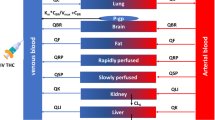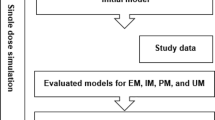Abstract
Background and Objectives
Lack of information on the pharmacokinetics of the active moiety of Cannabis or the metabolites of delta-9-tetrahydrocannabinol (THC) does not seem to be discouraging medical or recreational use. Cytochrome P450 (CYP) 2C9, the primary enzyme responsible for THC metabolism, has two single nucleotide polymorphisms—Arg144Cys (*2) and Ile359Leu (*3). In the Caucasian population, allelic frequency is between 0.08 and 0.14 for CYP2C9*2 and between 0.04 and 0.16 for CYP2C9*3. In vitro data suggest that metabolic capacity for the variants CYP2C9*2 and CYP2C9*3 is about one-third compared to wild-type CYP2C9. Previous work has suggested exposure to the terminal metabolite is genetically determined. We therefore sought to characterize the pharmacokinetics of THC and its major metabolites 11-hydroxy-delta-9-tetrahydrocannabinol (THC-OH) and 11-nor-9-carboxy-delta-9-tetrahydrocannabinol (THC-COOH) in healthy volunteers with known CYP2C9 status by non-compartmental analysis (NCA), compartmental modeling (CM) and minimal physiologically based pharmacokinetic (mPBPK) modeling.
Methods
Blood samples drawn for THC, THC-OH and THC-COOH after a single intravenous (IV) bolus of 0.1 mg/kg (0.32 μM/kg) THC were analyzed using a validated LC–MS/MS method. NCA generated initial estimates and CM and the mPBPK model were then fit to plasma concentration data using non-linear mixed-effects modeling. Blood samples from orally dosed (10, 25 and 50 mg) THC brownies were added to validate the model.
Results
THC can be described as a high hepatic extraction ratio drug with blood flow-dependent metabolism not restricted by protein binding. THC hepatic clearance is dependent on the CYP2C9 genetic variant in the population. High extraction drugs display route-dependent metabolism. When administered via the IV or inhalation routes, induction or inhibition of CYP2C9 should be non-contributory as the elimination of THC is dependent only on liver blood flow. THC-OH is also a high extraction ratio drug, but its hepatic clearance is significantly impacted by the hepatic diffusional barrier that impedes its access to hepatic CYP2C9. THC-COOH is glucuronidated and renally cleared; subjects homozygous for CYP2C9*3 have reduced exposure to this metabolite as a result of the polymorphism reducing THC production, the hepatic diffusional barrier impeding egress from the hepatocyte, and increased renal clearance.
Conclusion
It has recently been reported that the terminal metabolite THC-COOH is active, implying the exposure difference in individuals homozygous for CYP2C9*3 may become therapeutically relevant. Defining the metabolism of THC in humans is important, as it is increasingly being used as a drug to treat various diseases and its recreational use is also rising. We have used NCA, CM, and mPBPK modeling of THC and its metabolites to partially disentangle the complexity of cannabis disposition in humans.



Similar content being viewed by others
References
Legal Medical Marijuana States and DC. http://medicalmarijuana.procon.org. Accessed 28 Jan 2019.
Huestis MA. Pharmacokinetics and metabolism of the plant cannabinoids, delta-9-tetrahydrocannabinol, cannabidiol and cannabinol. Handb Exp Pharmacol. 2005;168:657–90.
Watanabe K, Yamaori S, Funahashi T, Kimura T, Yamamoto I. Cytochrome P450 enzymes involved in the metabolism of tetrahydrocannabinols and cannabinol by human hepatic microsomes. Life Sci. 2007;80(15):1415–9.
Bland TM, Haining RL, Tracy TS, Callery PS. CYP2C-catalyzed delta9-tetrahydrocannabinol metabolism: kinetics, pharmacogenetics and interaction with phenytoin. Biochem Pharmacol. 2005;70(7):1096–103.
Kirchheiner J, Brockmoller J. Clinical consequences of cytochrome P450 2C9 polymorphisms. Clin Pharmacol Ther. 2005;77(1):1–16.
Sachse-Seeboth C, Pfeil J, Sehrt D, et al. Interindividual variation in the pharmacokinetics of Delta9-tetrahydrocannabinol as related to genetic polymorphisms in CYP2C9. Clin Pharmacol Ther. 2009;85(3):273–6.
Kleine-Brueggeney M, Greif R, Brenneisen R, Urwyler N, Stueber F, Theiler LG. Intravenous delta-9-tetrahydrocannabinol to prevent postoperative nausea and vomiting: a randomized controlled trial. Anesth Analg. 2015;121(5):1157–64.
Vandrey R, Herrman ES, Mithcell JM, et al. Pharmacokinetic profile of oral cannabis in humans: blood and oral fluid disposition in relation to phamacodynamic outcomes. J Anal Toxicol. 2017;41:83–9.
Bernhard W, Wolowich WR, Sachs H, Kleine-Brueggeney M, Greif R, Theiler L. Influence of the genetic polymorphism in CYP2C9 on the pharmacokinetics of delta-9-tetrahydrocannabinol and introduction of a new pharmacokinetic model. In: Abstract K42. Proceedings of the American Academy of Forensic Sciences 66th annual meeting. Seattle, WA, February 17–22, 2014.
Fiserova-Bergerova V. Inhalation anesthesia using physiologically based pharmacokinetic models. Drug Metab Rev. 1992;24:531–57.
Li GF, Shan ZQ. Modeling drug disposition and drug-drug interactions through hypothesis-driven physiologically based pharmacokinetics: a reversal translation perspective. Eur J Drug Metab Pharmacokinet. 2018;43:369–71.
Tsamandouras N, Rostami-Hodjegaan A, Aarons L. Combining the bottom up and top down approaches in pharmacokinetic modelling: fitting PBPK models to observed clinical data. Br J Clin Pharmacol. 2013;79:48–55.
Wishart DS, Feunang YD, Guo AC, Lo EJ, Marcu A, Grant JR, Sajed T, Johnson D, Li C, Sayeeda Z, Assempour N, Iynkkaran I, Liu Y, Maciejewski A, Gale N, Wilson A, Chin L, Cummings R, Le D, Pon A, Knox C, Wilson M. DrugBank 5.0: a major update to the DrugBank database for 2018. Nucleic Acids Res. 2017. https://doi.org/10.1093/nar/gkx1037.
Brown RP, Delp MD, Lindstedt SL, Rhomberg LR, Belilies RP. Physiological parameter values for physiologically based pharmacokinetic models. Toxicol Ind Health. 1997;13:407–84.
Rowland M, Tozer TN. Metabolite kinetics. In: Rowland M, Tozer TN, editors. Clinical pharmacokinetics: concepts and applications. 2nd ed. Malvern: Lea & Febiger; 1989.
Bornheim LM, Lasker JM, Raucy JL. Human hepatic microsomal metabolism of delta-1-tetrahydrocannabinol. Drug Metab Dispos. 1992;20:241–6.
Mazur A, Lichti CF, Prather PL, et al. Characterization of human hepatic and extrahepatic UDP-glucuronosyltransferase enzymes involved in the metabolism of classic cannabinoids. Drug Metab Dispos. 2009;37:1496–504.
Dietz L, Glaz-Sandberg A, Nguyen H, Skopp G, Mikus G, Aderjan R. The urinary disposition of intravenously-administered 11-nor-9-carboxy-delta-9-tetrahydrocannabinol in humans. Ther Drug Monit. 2007;3:368–72.
Cockcroft DW, Gault MH. Prediction of creatinine clearance from serum creatinine. Nephron. 1976;16:31–41.
Berezhkovskiy LM. Determination of volume of distribution at steady state with complete consideration of the kinetics of protein and tissue binding in linear pharmacokinetics. J Pharm Sci. 2004;93(2):364–74 (PubMed PMID: 14705193).
Piotrovski V, Van Peer A. A model with separate hepato-portal compartment (“first pass” model): fitting to plasma concentration-time profiles in humans. Pharm Res. 1997;14:230–7.
Pang KS, Maeng HJ, Fan J. Interplay of transporters and enzymes in drug and metabolite processing. Mol Pharm. 2009;6:1734–55.
Maurer HH, Sauer C, Theobald DS. Toxicokinetics of drugs of abuse: current knowledge of the isoenzymes involved in the human metabolism of tetrahydrocannabinol, cocaine, heroin, morphine, and codeine. Ther Drug Monit. 2006;28(3):447–53.
Grotenhermen F. Pharmacokinetics and pharmacodynamics of cannabinoids. Clin Pharmacokinet. 2003;42:327–60.
Yang J, Jamei M, Yeo KR, Rostami-Hodjegan A, Tucker GT. Misuse of the well-stirred model of hepatic drug clearance. Drug Metab Dispos. 2007;35:501–2.
Park R, Leach WJ, Arieff AI. Determination of liver intracellular pH in vivo and its homeostasis in acute acidosis and alkalosis. Am J Physiol. 1979;236(3):F240–5.
Thompson MD, Beard DA, Wu F. Use of partition coefficients in flow-limited physiologically-based pharmacokinetic modeling. J Pharmacokinet Pharmacodyn. 2012;39:313–27.
Heuberger JA, Guan Z, Oyetayo OO, et al. Population pharmacokinetic model of THC integrates oral, intravenous, and pulmonary dosing and characterizes short- and long-term pharmacokinetics. Clin Pharmacokinet. 2015;54(2):209–19.
Awasthi R, An G, Donovan MD, Boles Ponto LL. Relating observed psychoactive effects to the plasma concentrations of delta-9-tetrahydrocannabinol and its active metabolite: an effect-compartment modeling approach. J Pharm Sci. 2018;107:745–55.
Marsot A, Audebert C, Attolini L, Lacarelle B, Micallef J, Blin O. Population pharmacokinetics model of THC used by pulmonary route in occasional cannabis smokers. J Pharmacol Toxicol Methods. 2017;85:49–54.
Hendeles L, Weinberger M, Milavetz G, Hill M 3rd, Vaughan L. Food-induced, “dose-dumping” from a once-a day theophylline product as a cause of theophylline toxicity. Chest. 1985;87:758–65.
Lembeger L, Martz R, Rodda B, Forney R, Rowe H. Comparative pharmacology of delta-9-tetrahydrocannabinol and its metabolite, 11-OH-delta-9-tetrahydrocannabinol. J Clin Invest. 1973;52:2411–7.
Hunt CA, Jones RT. Tolerance and disposition of tetrahydrocannabinol in man. J Pharmacol Exp Ther. 1980;215(1):35–44.
Wall ME, Sadler BM, Brine D, Taylor H, Perez-Reyes M. Metabolism, disposition and kinetics of delta-9-tetrahydrocannabinol in men and women. Clin Pharmacol Ther. 1983;34:352–63.
Gillette JR, Pang KS. Theoretical aspects of pharmacokinetic drug interactions. Clin Pharmacol Ther. 1997;22:623–39.
Lutz JD, Fujioka Y, Isoherranen N. Rationalization and prediction of in vivo metabolite exposures: the role of metabolite kinetics, clearance predictions and in vitro parameters. Expert Opin Drug Metab Toxicol. 2010;6(9):1095–109.
Yang F, Xiong X, Liu Y, et al. CYP2C9 and OATP1B1 genetic polymorphisms affect the metabolism and transport of glimepiride and gliclazide. Sci Rep. 2018;8(1):10994. https://doi.org/10.1038/s41598-018-29351-4 (Published 2018 Jul 20).
Brunet B, Doucet C, Venisse N, et al. Validation of large white pig as an animal model for the study of cannabinoids metabolism: application to the study of THC distribution in tissues. Forensic Sci Int. 2006;161:169–74.
Bonate PL. Nonlinear mixed effects models: practical issues. In: Bonate PL, editor. Pharmacokinetic–pharmacodynamic modeling and simulation. 2nd ed. New York: Springer; 2011. p. 303.
Wilsey BL, Deutsch R, Samara E, et al. A preliminary evaluation of the relationship of cannabinoid blood concentrations with the analgesic response to vaporized cannabis. J Pain Res. 2016;9:587–98.
Cooper ZD, Haney M. Sex-dependent effects of cannabis-induced analgesia. Drug Alcohol Depend. 2016;167:112–20.
LeFoll B, Tyndale RF. Cannabinoids: friend or foe? Clin Pharmacol Ther. 2015;97(6):528–31.
D’Souza DC, Ranganathan M. Medical marijuana–is the cart before the horse? JAMA. 2015;313(24):2431–2.
Volkow ND, Baler RD, Compton WM, Weiss SRB. Adverse health effects of marijuana use. N Engl J Med. 2014;370(23):2219–27.
Hiratsuka M. Genetic polymorphisms and in vitro functional characterization of CYP2C8, CYP2C9, and CYP2C19 allelic variants. Biol Pharm Bull. 2016;39:1748–59.
Noble MJ, Hedberg K, Hendrickson RG. Acute cannabis toxicity. Clin Toxicol (Phila). 2019;24:1–8. https://doi.org/10.1080/15563650.2018.1548708.
Acknowledgements
This work is dedicated to the memory of our colleague and friend, Hans Sachs (12.7.1948–10.3.2017), former head of the Forensic and Toxicologic Center, FTC GmbH, Munich, Germany. Doctor Sachs provided all analytic results of the THC data and contributed greatly to the manuscript. Without him, this manuscript would never have been written. Dr. Wolowich would also like to acknowledge personal conversations with KS Pang, WJ Jusko and Dr. Ryan Vandrey who graciously allowed the use of his oral cannabis study data. This work was presented, in part at the American College of Clinical Pharmacology, September, 2016 in Bethesda, MD, USA; the 8th Swiss Pharma Science Day, August, 2015 Bern, Switzerland; the Annual Meeting American Academy of Forensic Science, February, 2014, Seattle, WA, USA; the American Conference of Pharmacometrics Annual Meeting, May, 2013, Ft. Lauderdale FL, USA; and the American Society of Anesthesiology Annual Meeting, Chicago, IL, USA in October, 2011.
Author information
Authors and Affiliations
Contributions
WRW was responsible for writing the manuscript and all pharmacokinetic data analysis and mPBPK modeling. RG designed and conducted sampling of the probes, and revised the manuscript. MKB designed the study, helped with the conduct of the study and with writing of the manuscript. WB helped design the study, tested the quality of the THC solution used for the injection and coordinated the analysis of the probes. LT designed the study, and helped in writing the manuscript of this study.
Corresponding author
Ethics declarations
Funding
No source of funding was used for this study.
Conflict of interest
All authors have no conflict of interest to declare.
Ethics approval
All procedures performed in studies involving human participants were in accordance with the ethical standards of the Institutional Review Board approval (Cantonal Ethics Committee Bern Approval#: KEK 241–09, ISRCTN 53019164) and permission of all relevant bodies (BAG, Swissmedic) and with the 1964 Helsinki declaration and its later amendments or comparable ethical standards.
Informed consent
Written informed consent was obtained from all volunteers.
Electronic supplementary material
Below is the link to the electronic supplementary material.
Rights and permissions
About this article
Cite this article
Wolowich, W.R., Greif, R., Kleine-Brueggeney, M. et al. Minimal Physiologically Based Pharmacokinetic Model of Intravenously and Orally Administered Delta-9-Tetrahydrocannabinol in Healthy Volunteers. Eur J Drug Metab Pharmacokinet 44, 691–711 (2019). https://doi.org/10.1007/s13318-019-00559-7
Published:
Issue Date:
DOI: https://doi.org/10.1007/s13318-019-00559-7




